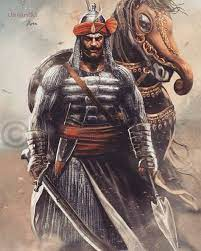About Indian Kings....
Indian kings...
Maharana Pratap
Maharana Pratap was a Rajput king of Mewar, a region in North-western India in the 16th century. He is known for his resistance against the Mughal Empire, which was expanding its control over India at the time. He is considered as a symbol of Rajput chivalry and resistance to Mughal rule in Rajasthan.
Maharana Pratap was born in 1540 and was the eldest son of Udai Singh II, the Rajput king of Mewar. He was the ruler of Mewar from 1572 until his death in 1597.
Maharana Pratap is particularly remembered for his resistance against the Mughal emperor Akbar, who sought to expand Mughal control over Mewar. The famous battle between Maharana Pratap and Akbar took place in 1576 at Haldighati, near Udaipur. Although Maharana Pratap's army was outmatched by the Mughals, the Rajputs put up a fierce resistance and Maharana Pratap managed to evade capture and escape.
After this battle, Maharana Pratap continued to resist the Mughals through guerrilla warfare, with the support of his loyal followers, known as the Bhil tribes. He is also known for his efforts to bring about unity among the Rajput kings and to strengthen the Rajput confederacy.
Maharana Pratap is still considered a hero in Rajasthan and is remembered for his courage and determination in resisting Mughal rule. He is a symbol of Rajput pride and valor and his legacy continues to be celebrated in the state of Rajasthan.
Chhatrapati Shivaji Maharaj...
Shivaji Bhonsle, also known as Chhatrapati Shivaji Maharaj, was a Maratha warrior king and the founder of the Maratha Empire in western India in the 17th century. He is considered one of the greatest warriors in Indian history and is a symbol of regional pride in the state of Maharashtra.
Shivaji was born in 1630 in the hill-fort of Shivneri, near the city of Junnar in what is now the state of Maharashtra. He was the son of Shahaji Bhonsle, a Maratha warrior, and Jijabai, a devout Hindu. He was raised and trained as a warrior from a young age.
Shivaji began his military career by building a small but powerful army, using guerilla tactics to capture forts and territory from the Muslim Adilshahi and Nizamshahi sultanates. He also built a powerful navy and established a system of forts along the western coast of India to protect his kingdom from foreign invasions.
Shivaji is known for his military tactics, his administration and his policies of religious tolerance. He set up a central administration and a system of governance based on the principles of justice, welfare and good governance, which became the model for the Maratha Empire. He was also an advocate of religious tolerance, and was known to have appointed people from all religions to positions of power in his administration.
In 1674, he was crowned as the Chhatrapati (Emperor) of the Maratha Kingdom, thus he was known as Chhatrapati Shivaji Maharaj, He died in 1680, but his legacy lives on in the state of Maharashtra, where he is still celebrated as a symbol of regional pride and a hero of the Maratha people.
Chandragupta Maurya...
Chandragupta Maurya: He was the founder of the Maurya Empire and the first ruler to unify most of the Indian subcontinent. He ruled from 322 BCE to 298 BCE.
These are just a few examples of the many powerful kings and emperors who have shaped India's history over the centuries. Each of them had their own legacy, culture and impact in the Indian subcontinent.



.jpg)

These is our real hero
ReplyDelete